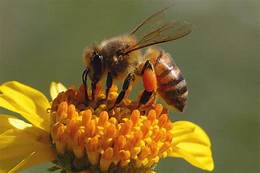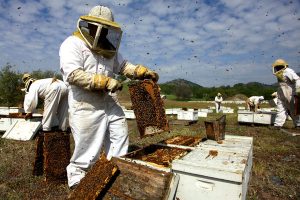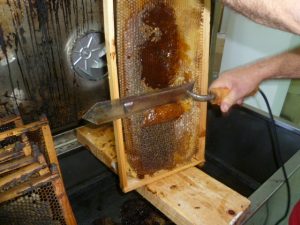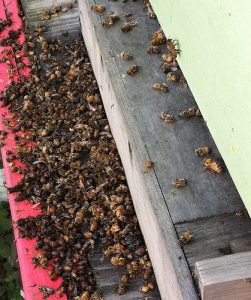 Here’s a photo of me at seven with an armload of sweet tangerines picked from a tree in our backyard. We always had a nice crop of tangerines to enjoy, but there wouldn’t be fruit, flowers, or other plants without bees to pollinate them. Without plants to eat and refresh the earth’s oxygen supply, humans would perish. We owe our very survival to bees.
Here’s a photo of me at seven with an armload of sweet tangerines picked from a tree in our backyard. We always had a nice crop of tangerines to enjoy, but there wouldn’t be fruit, flowers, or other plants without bees to pollinate them. Without plants to eat and refresh the earth’s oxygen supply, humans would perish. We owe our very survival to bees.
I’m often asked if vegans eat honey. The answer is no. Honey, like other animal products, is derived from exploitation and suffering.
A honeybee hive consists of tens of thousands of bees, each with his or her own mission that is determined by the bee’s sex and age as well as by the time of year. Each hive usually has one queen, hundreds of drones, and thousands of workers. Queens can live as long as seven years, while other bees have life spans ranging from a few weeks to six months.
 Drones serve the queen, who is responsible for reproduction. She lays about 250,000 eggs each year, as many as one million over the course of her lifetime. Worker bees are responsible for feeding the brood, caring for the queen, building comb, foraging for nectar and pollen, and cleaning, ventilating, and guarding the hive. As the temperature drops in the winter, the bees cluster around the queen and her young, using their body heat to keep the temperature inside the hive steady at around 93 degrees Fahrenheit.
Drones serve the queen, who is responsible for reproduction. She lays about 250,000 eggs each year, as many as one million over the course of her lifetime. Worker bees are responsible for feeding the brood, caring for the queen, building comb, foraging for nectar and pollen, and cleaning, ventilating, and guarding the hive. As the temperature drops in the winter, the bees cluster around the queen and her young, using their body heat to keep the temperature inside the hive steady at around 93 degrees Fahrenheit.
A Language All Their Own
Bees have a unique and complex form of communication based on sight, motion, and scent that scientists and scholars still don’t fully understand. Bees alert other members of their hive to food, new hive locations, and conditions (such as nectar supply) within their hive through intricate “dance” movements.
Studies have shown that bees are capable of abstract thinking as well as distinguishing their family members from other bees, using visual cues to map their travels, and locating previously used food sources even if their home has been moved. And, similar to the way smells can invoke powerful memories in for humans, they also trigger memories in bees, such as where the best food can be found.
 Manipulating Nature
Manipulating Nature
Profiting from honey requires human manipulation and exploitation of the insects’ desire to live and protect their hive. Humans have been consuming honey since about 15,000 B.C., but it wasn’t until very recently in human history that people have turned bees into factory-farmed animals. Like other factory-farmed animals, honeybees are victims of unnatural living conditions, genetic manipulation, and stressful transportation.
The familiar white box beehive has been around since the mid-1850s and was created so that beekeepers could move hives from place to place. As The New York Times describes it, bees have been “moved from shapes that accommodated their own geometry to flat-topped tenements, sentenced to life in file cabinets.”
 Even though bees may prefer the nectar of one or more flowers or plants, it’s common beekeeping practice to place the artificial hives in fields where only one type of plant is available, leaving the bees no options in nectar gathering. In addition, when beekeepers drain hives of the honey the bees have made to feed themselves to sell it to humans, they give the hungry bees sugary syrups, like high-fructose corn syrup, to eat instead. Scientists have confirmed that this practice is causing bees to suffer from malnutrition.
Even though bees may prefer the nectar of one or more flowers or plants, it’s common beekeeping practice to place the artificial hives in fields where only one type of plant is available, leaving the bees no options in nectar gathering. In addition, when beekeepers drain hives of the honey the bees have made to feed themselves to sell it to humans, they give the hungry bees sugary syrups, like high-fructose corn syrup, to eat instead. Scientists have confirmed that this practice is causing bees to suffer from malnutrition.
When a new queen is about to be born, the old queen and half the hive leave their home and set up in a new place found by scouting worker bees. This “swarming,” as it’s known, can cause a decline in honey production. Beekeepers do inhumane things to prevent swarming, including clipping the wings of a new queen, killing and replacing an older queen after just one or two years, and confining a queen who is ready to initiate a swarm.
 Queens are often forcibly taken from hives and artificially inseminated using drones, who are killed in the process. When beekeepers decide to move a queen to another colony, she is transported along with “bodyguard” bees, all of whom, if they survive the move, will be killed by bees in the new colony. Many bees are killed or have their wings and legs torn off by haphazard handling by beekeepers.
Queens are often forcibly taken from hives and artificially inseminated using drones, who are killed in the process. When beekeepers decide to move a queen to another colony, she is transported along with “bodyguard” bees, all of whom, if they survive the move, will be killed by bees in the new colony. Many bees are killed or have their wings and legs torn off by haphazard handling by beekeepers.
What You Can Do
Avoid honey, beeswax, propolis, royal jelly, and other products that come from the exploitation of bees. Vegan lip balms and candles are readily available. Agave nectar, rice syrup, molasses, sorghum, barley malt, maple syrup, and dried fruit or fruit concentrates can be used to replace honey in recipes. Sweet, delicious, and healthy meals and desserts can be enjoyed without the suffering of vitally important bees.
Peace for ALL the animals with whom we share this planet!
